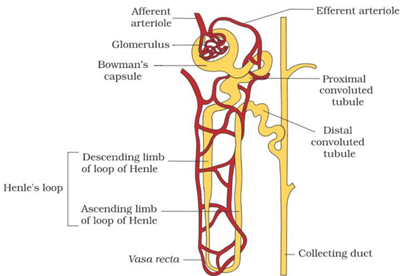Match the terms given in Column I with their physiological processes given in Column II and choose the correct answer
Column I Column II

Proximal convoluted tubule leads to reabsorption of 70-80% electrolyte. It also maintains the pH and the ionic balance of the body fluids by selective secretion of hydrogen ions, ammonia and potassium ions into the filtrate and by absorption of bicarbonate ions.
Distal convoluted tubule maintains the ionic balance. Conditional reabsorption of Na+ and water takes place in this part.
Henle's loop leads to formation of concentrated urine. Reabsorption is minimum in its ascending limb and the descending limb of loop of Henle is permeable to water but almost impermeable to electrolytes. This concentrates the filtrate as it moves down the loop.
Counter current mechanism results in maintenance of concentration gradient in medulla. Presence of such gradient helps in passage of water from the collecting tubule thus concentrating the urine.
Renal corpuscle leads to filtration of blood.
